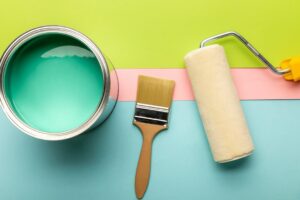When it comes to painting, everyone wants a finish that will last through the years—one that resists chipping, fading, peeling, and looks just as good as it did on day one. But what makes some paints hold up better than others?
The answer lies in the science of paint formulation, and how specific chemical and physical properties contribute to durability. In this post, we’ll break down the key factors that make paint long-lasting, from the composition of binders and pigments to additives and environmental resilience.
1. The Core Components of Paint: An Overview
Understanding what’s in your paint is the first step to understanding its durability. Paint generally consists of four main components: binders, pigments, solvents, and additives. Each of these elements plays a unique role in how the paint performs and withstands wear over time.
a) Binders
- Purpose: The binder, also known as the resin, is responsible for the adhesion, durability, and flexibility of the paint film. It forms the film that binds the pigment particles together and to the painted surface.
- Types:
- Acrylic Resins: Known for their flexibility and UV resistance, acrylic binders are common in high-quality latex (water-based) paints. They make the paint resistant to cracking and peeling, even under exposure to sunlight.
- Alkyd Resins: Common in oil-based paints, alkyd resins are durable and offer strong adhesion, making them great for high-traffic areas. They’re more resistant to moisture, but less flexible than acrylics.
- Epoxy Resins: Often found in industrial coatings, epoxies are extremely durable and offer excellent chemical resistance, making them ideal for environments that face heavy wear and tear.
b) Pigments
- Purpose: Pigments provide color, opacity, and in some cases, protective properties. They contribute significantly to the paint’s visual appeal and coverage.
- Types:
- Organic Pigments: Generally provide brighter colors but tend to fade faster under UV exposure.
- Inorganic Pigments: Offer better UV resistance and durability, though their colors are usually more muted.
- Titanium Dioxide (TiO2): A key pigment in white and lighter shades, titanium dioxide is highly durable, UV-resistant, and provides excellent opacity, which helps achieve solid coverage with fewer coats.
c) Solvents
- Purpose: The solvent, or carrier, is the liquid component that keeps the paint in a usable, spreadable form. Once applied, it evaporates, allowing the paint film to form and adhere to the surface.
- Types:
- Water: Used in water-based paints (like latex), water evaporates quickly and is low in volatile organic compounds (VOCs), making it more environmentally friendly.
- Oil: In oil-based paints, oil solvents evaporate slower, allowing for a more level, durable finish but with higher VOC content.
d) Additives
- Purpose: Additives are included in the paint formula to enhance certain properties, such as drying time, mildew resistance, flow, leveling, and durability.
- Common Additives:
- Anti-fungal agents: Prevent mold and mildew growth, especially in humid environments.
- UV stabilizers: Protect the paint from the sun’s UV rays, preventing color fading and chalking.
- Flow agents: Ensure a smooth application by preventing brush marks or roller lines from appearing on the surface.
2. How Paint Forms a Durable Film: The Drying and Curing Process
The drying and curing process is fundamental to achieving a durable finish. This process differs for water-based and oil-based paints.
a) Water-Based Paints (Latex or Acrylic)
- Drying: In water-based paints, drying happens as the water in the paint evaporates. This allows the acrylic or latex polymers to come together and form a continuous film.
- Curing: After drying, the paint cures over time, during which the polymers cross-link, creating a durable, cohesive film. Curing typically takes about 2-4 weeks, during which the paint should be treated with care to avoid smudges or scratches.
b) Oil-Based Paints
- Oxidation: Oil-based paints undergo an oxidation process rather than simple drying. When exposed to air, the oils in the paint react with oxygen to form a hard, durable film.
- Curing: This process is slower but results in a finish that’s often more durable than water-based paints. However, the higher VOCs released can be a drawback, especially in poorly ventilated spaces.
3. Key Qualities that Make Paint Durable
a) Adhesion
- Description: Paint durability begins with adhesion, the ability of the paint to stick to the surface. Poor adhesion leads to peeling and flaking over time.
- Enhancement: High-quality binders, along with proper surface preparation (like cleaning and priming), are essential to ensure the paint bonds well to the substrate.
b) Flexibility
- Description: Paint that is too rigid may crack over time as it reacts to temperature fluctuations and moisture changes. Flexibility allows paint to expand and contract with the substrate.
- Enhancement: Acrylic binders are highly flexible and resilient, making latex paints a great choice for surfaces that experience temperature variations.
c) UV Resistance
- Description: UV rays from sunlight can break down paint’s molecular structure, causing colors to fade and surfaces to chalk.
- Enhancement: Inorganic pigments and UV stabilizers can greatly enhance UV resistance, making the paint last longer on exterior surfaces.
d) Moisture Resistance
- Description: Water is one of paint’s biggest enemies, leading to blistering, peeling, and mildew growth.
- Enhancement: The right binder, often epoxy or alkyd for high-moisture areas, can increase moisture resistance. Anti-fungal additives are also critical in areas prone to high humidity, like bathrooms and basements.
4. The Role of Primers in Achieving Durability
Using a primer before painting is a crucial step in extending the life of the paint job.
a) Purpose of Primers
- Primers improve paint adhesion, providing a consistent surface that allows the paint to bond properly.
- They help seal porous surfaces, preventing excessive paint absorption that can result in uneven patches.
- For dark colors, tinted primers help reduce the number of coats needed, while special primers block stains and prevent bleed-through.
b) Types of Primers
- Acrylic Primers: Versatile and ideal for interior and exterior surfaces, they work well under latex paint.
- Oil-Based Primers: Suitable for high-moisture areas and for use under oil-based paint.
- Stain-Blocking Primers: Designed for surfaces with smoke, water, or grease stains, blocking them from showing through the final paint layer.
5. Color and Pigment Retention
The type and quality of pigments used in paint affect its durability, especially when exposed to sunlight.
a) Organic vs. Inorganic Pigments
- Organic pigments provide more vibrant colors but tend to fade faster under UV exposure.
- Inorganic pigments, like those derived from metals or minerals, offer greater color stability and UV resistance, making them ideal for exterior paints.
b) Titanium Dioxide: A Key Player
- Titanium dioxide (TiO₂) is a popular pigment in light-colored paints due to its high opacity, UV resistance, and ability to reflect light, which enhances the durability of the color over time.
6. Environmental Considerations
The durability of paint can vary significantly depending on the environment in which it’s applied. High UV exposure, humidity, salt air, and fluctuating temperatures can all impact paint performance.
a) High Humidity and Rainfall
- In humid or rainy climates, moisture-resistant paints with anti-fungal additives are crucial for longevity. Latex-based paints are usually preferred for exteriors, as they breathe and allow moisture to escape, reducing the risk of bubbling or peeling.
b) High UV Exposure
- Intense sunlight can fade colors, chalk surfaces, and degrade binders. In these areas, using high-quality exterior-grade paints with UV-resistant additives and inorganic pigments is essential.
c) Temperature Fluctuations
- Environments with extreme temperature changes can lead to expansion and contraction of painted surfaces. Flexible binders, like acrylics, help prevent cracking and maintain a solid, cohesive film under these conditions.
7. Maintenance Tips to Prolong Paint Durability
Once applied, maintaining your paint job can further extend its life. Regular cleaning, avoiding harsh chemicals, and monitoring for early signs of wear can keep your paint looking fresh for years.
a) Clean Gently
- Use a soft, damp cloth or sponge to remove dust and grime. Avoid abrasive scrubbing tools, which can wear down the paint film.
b) Touch Up as Needed
- Small chips and scratches can be touched up to prevent them from spreading. Store extra paint in a cool, dry place for easy touch-ups when needed.
c) Reapply Clear Protective Coatings for Extra Durability
- For high-traffic areas, consider applying a clear topcoat or sealer. This adds an additional layer of protection against scratches, stains, and moisture.
Final Thoughts
The durability of paint is a complex interplay of chemistry, environmental factors, and application techniques. By understanding the science behind paint components and selecting products suited to your needs, you can achieve a beautiful, long-lasting finish.
Whether for interiors or exteriors, choosing the right paint, preparing the surface properly, and applying the paint with attention to detail will ensure that your project endures and remains vibrant over time. For that perfect finish? Speak to us!





